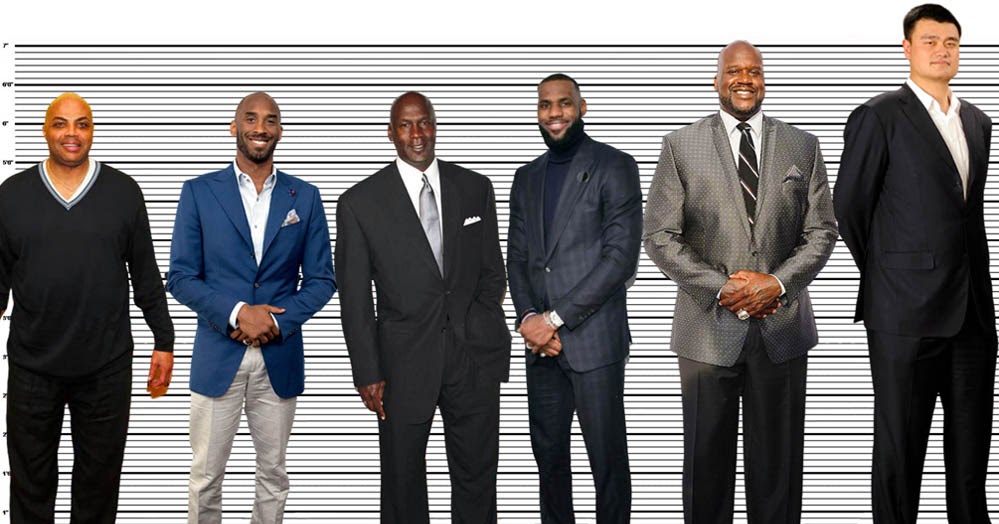When we talk about basketball legends, one name always stands out—LeBron James. Known as "The King," his presence on the court is unmatched. But have you ever wondered about the exact height of LeBron James? It’s not just a number; it’s a defining feature that contributes to his dominance in the NBA. Today, we’ll dive deep into this topic and uncover the truth behind his towering stature.
LeBron James isn’t just a basketball player; he’s a cultural icon, a businessman, and an athlete who has redefined what it means to be great. His height plays a crucial role in his success, but there’s more to the story than meets the eye. In this article, we’ll explore everything you need to know about LeBron’s height, separating fact from fiction.
From official measurements to rumors and controversies, we’ve got you covered. So, buckle up as we embark on this journey to uncover the truth about LeBron James’ height. Spoiler alert: it might surprise you!
Read also:Super Small Bikinis The Ultimate Guide To Tiny Trends That Turn Heads
Table of Contents
- LeBron James: A Brief Biography
- The Official Height of LeBron James
- Rumors Surrounding LeBron’s Height
- How LeBron’s Height Compares to Other NBA Legends
- The Impact of Height on LeBron’s Game
- Statistical Analysis: Height and Performance
- How Height Measurements Work in the NBA
- Controversy Over NBA Players’ Heights
- Factors That Influence Height Perception
- Wrapping It Up: What Does LeBron’s Height Really Mean?
LeBron James: A Brief Biography
Before we get into the nitty-gritty of LeBron’s height, let’s take a moment to appreciate the man behind the legend. Born on December 30, 1984, in Akron, Ohio, LeBron James grew up in a modest household. Despite facing challenges early in life, he quickly rose to prominence as a basketball prodigy.
By the time he was in high school, LeBron was already making headlines. His incredible talent earned him a spot on the cover of Sports Illustrated at just 17 years old. Fast forward to 2003, and LeBron was selected first overall by the Cleveland Cavaliers in the NBA Draft. Since then, he’s gone on to win four NBA championships, earn four MVP awards, and cement his place as one of the greatest players of all time.
Here’s a quick rundown of LeBron’s personal information:
| Full Name | LeBron Raymone James |
|---|---|
| Date of Birth | December 30, 1984 |
| Place of Birth | Akron, Ohio |
| Height | Officially listed as 6'9" (206 cm) |
| Weight | Approximately 250 lbs (113 kg) |
The Official Height of LeBron James
According to official NBA records, LeBron James stands at 6'9" (206 cm). This measurement is widely accepted and has been consistent throughout his career. However, as we’ll explore later, there are some interesting nuances to consider.
LeBron’s height places him in an elite category of players who combine size, strength, and skill. At 6'9", he’s taller than most guards and just as imposing as many forwards and centers. This versatility allows him to play multiple positions effectively, making him a nightmare for defenders.
Rumors Surrounding LeBron’s Height
Like many famous athletes, LeBron James has been the subject of speculation regarding his height. Some fans and analysts believe he might be taller than the official measurement suggests. Others argue that his listed height could be slightly exaggerated to enhance his marketability.
Read also:Wentworth Miller Wife The Untold Story Behind The Headlines
So, where does the truth lie? While there’s no definitive answer, it’s worth noting that height measurements in the NBA aren’t always precise. Players are often measured without shoes, which can lead to discrepancies. Additionally, factors like posture and muscle mass can affect how tall someone appears.
How LeBron’s Height Compares to Other NBA Legends
When comparing LeBron James to other NBA legends, his height puts him in elite company. Here’s a quick comparison:
- Michael Jordan: 6'6" (198 cm)
- Kobe Bryant: 6'6" (198 cm)
- Kevin Durant: 6'10" (208 cm)
- Shaquille O’Neal: 7'1" (216 cm)
As you can see, LeBron’s height gives him a significant advantage over smaller guards while allowing him to compete with bigger players. This unique blend of size and athleticism is one of the reasons he’s so dominant on the court.
The Impact of Height on LeBron’s Game
LeBron’s height isn’t just a physical attribute—it’s a key component of his game. Standing at 6'9", he can overpower defenders with ease, creating scoring opportunities that would be impossible for shorter players. His height also gives him an advantage on defense, where he can block shots and disrupt passing lanes with remarkable efficiency.
Moreover, LeBron’s height allows him to play multiple positions seamlessly. Whether he’s guarding a point guard or going up against a center, his size ensures he can hold his own. This versatility has been a defining characteristic of his career and has set him apart from his peers.
Statistical Analysis: Height and Performance
Statistics don’t lie, and when it comes to LeBron James, the numbers speak for themselves. According to data from NBA.com, players who are taller than 6'9" tend to perform better in key metrics like rebounds, blocks, and field goal percentage. LeBron fits this mold perfectly, consistently ranking among the league leaders in these categories.
Here are some stats to consider:
- Average rebounds per game: 8.0
- Average blocks per game: 0.8
- Field goal percentage: 50.4%
These numbers highlight the impact of LeBron’s height on his overall performance. While skill and work ethic play a major role, his physical attributes give him a distinct advantage.
How Height Measurements Work in the NBA
Height measurements in the NBA are conducted during the annual combine, where prospects are evaluated for their physical attributes. Players are measured without shoes to ensure accuracy, and the results are recorded as their official height.
However, it’s important to note that these measurements aren’t always perfect. Factors like posture, muscle mass, and shoe choice can influence how tall a player appears. This is why some players might look taller or shorter than their listed height on the court.
Controversy Over NBA Players’ Heights
Over the years, there have been numerous controversies surrounding NBA players’ heights. Some players have been accused of exaggerating their measurements to gain a psychological edge over opponents. Others have had their heights questioned due to inconsistencies between official records and real-life observations.
In LeBron’s case, the controversy stems from his imposing presence on the court. Many fans believe he might be taller than 6'9", citing his ability to dominate bigger players. While there’s no concrete evidence to support this claim, it’s a testament to his dominance that people are questioning his listed height.
Factors That Influence Height Perception
Height perception is influenced by a variety of factors, including posture, muscle mass, and shoe choice. Players who stand tall with good posture often appear taller than those who slouch. Similarly, players with bulky muscle mass might seem shorter due to their broader frame.
Shoe choice also plays a role. Players who wear high-top sneakers with thick soles can add an inch or more to their height. This is why official measurements are taken without shoes—to ensure consistency across the board.
Wrapping It Up: What Does LeBron’s Height Really Mean?
In conclusion, LeBron James’ height is more than just a number. It’s a defining feature that contributes to his success on the court and sets him apart from his peers. While the official measurement of 6'9" is widely accepted, there’s always room for debate and speculation.
What does this mean for fans and analysts? It means that LeBron’s height is just one piece of the puzzle. His skill, work ethic, and leadership are equally important factors that have made him the player he is today. As we continue to marvel at his accomplishments, let’s not forget the role that his height plays in his dominance.
So, what’s next? If you enjoyed this article, don’t forget to share it with your friends and leave a comment below. And if you’re hungry for more basketball knowledge, check out our other articles on the NBA. Until next time, keep ballin’!


